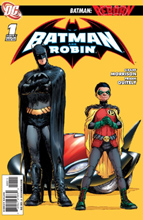 Diantha McBride's article for School Library Journal described several disparate things she as a school librarian would like to see from publishers, including:
Diantha McBride's article for School Library Journal described several disparate things she as a school librarian would like to see from publishers, including:
I need more books for boys--as do most librarians who work with young people. I've noticed that lots of books with female characters aren't really about being female. In fact, in many cases, the main characters could just as easily have been males--and that would make my job a lot easier.
Our young guys love Anthony Horowitz's “Alex Rider” series (Philomel), Dav Pilkey's stuff, and Jonathan London and Frank Remkiewicz's “Froggy” books (Viking). But a novel like Ann Halam's Siberia (Random House, 2005) could have included a male protagonist. (Sorry, Ann, but it's true.) And Gloria Whelan's The Impossible Journey (HarperCollins, 2003) could have featured an older brother and a younger sister--instead of 13-year-old Marya and her younger brother, Georgi.
Am I being silly? Probably, but some of our boys have never read a complete book in their lives. It's important to offer them good, appealing stories, and, sad to say, that means stories with prominent male characters.
Martha Brockenbrough at MSN Movie News, of all places, replied to McBride with an essay titled "Are We Letting Boys Be Book Bigots?" Her main point: the problem isn't the books, it's the way we're raising our boys. If they aren't willing to read about girls, and if we're indulging that sort of nonsense, then we are raising boys who will have a hard time functioning in a world where girls play serious roles. In other words, the real world. . . .
We need to teach them to take an interest in all sorts of stories, not just the ones that feature kids like them. This means exposing them to a lot of different stuff. We should, of course, encourage kids to find themselves in books. That's a wonderful and powerful thing. But we should help them find people who are different, too, so they learn to value other ways of being in the world.
I agreed with that sentiment, but as I considered my response to the discussion I felt something nag at me. It took a while before I realized what it was. McBride's complaint is based on a false premise: that we're drastically undersupplied with books about boys.
There are hundreds of new children's books published each month. And older books don't expire at the end of the year; they're still on shelves, too. Plus, the internet has made more books more widely available than ever in the history of literature. Surely among all those thousands of books there are enough with male protagonists for a boy with that requirement to read for an entire year. He just needs to know about them. But publishers aren't hiding that information.
Furthermore, McBride works at the American School of Madrid, which is hardly representative of American school libraries. I suspect the boys there come largely from the upper and upper-middle classes, with cosmopolitan parents who value education and have the means to provide it. If those boys "have never read a complete book in their lives," even when their librarian knows about Pilkey and Horowitz, then they must be making an effort to resist.
McBride is apparently willing to spend her budget on new, unproven books with male protagonists because her male students tell her they can't find anything interesting to read. Those are probably the same boys who stand in front of an open refrigerator complaining that they can't find any food.
 This is an illustration by Lisbeth Zwerger from her 1996 edition of The Wizard of Oz.
This is an illustration by Lisbeth Zwerger from her 1996 edition of The Wizard of Oz.


 Diantha McBride's
Diantha McBride's 






 And below is another explanation, based on personality rather than fighting tactics, from Dick Grayson to Damian Wayne in the latest issue of Batman--also scripted by Winick.
And below is another explanation, based on personality rather than fighting tactics, from Dick Grayson to Damian Wayne in the latest issue of Batman--also scripted by Winick.


 As I discussed in the last
As I discussed in the last  That of course makes a big contrast with Dick Grayson's usually light-hearted attitude. To build on
That of course makes a big contrast with Dick Grayson's usually light-hearted attitude. To build on  And that's not all. Over the past twenty years, DC's writers have presented Dick's sense of humor as having important meaning for Bruce Wayne. Despite his dark personality and pessimism, Bruce enjoyed Dick's jokes and happy attitude. Seeing Dick have fun kept Bruce level.
And that's not all. Over the past twenty years, DC's writers have presented Dick's sense of humor as having important meaning for Bruce Wayne. Despite his dark personality and pessimism, Bruce enjoyed Dick's jokes and happy attitude. Seeing Dick have fun kept Bruce level. Thus, Robin's puns, which started in 1940 as simple
Thus, Robin's puns, which started in 1940 as simple 


